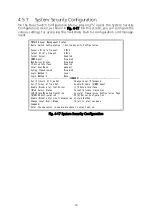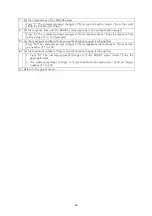
47
Available commands are listed below.
A
Enable/disable the trap sending when an SNMP authentication fails.
Press "A." The command prompt changes to "Enable or Disable SNMP Authentication
trap(E/D)>." Press "E" to enable the trap sending. Press "D" to disable it.
P
Add a port for which the trap is sent when its link status changes.
Press "P." The command prompt changes to "Enter port number>." Enter a port number. The
trap is sent for this port.
D
Delete a port for which the trap is sent when its link status changes.
Press "D." The command prompt changes to "Enter port number>." Enter a port number.
The trap is not sent for this port.
E
Enable/disable the trap sending when the power usage percentage exceeds the Power Usage
Threshold For Sending Trap, as set on the PoE Global Configuration Menu.
Press "E." The command prompt changes to "Enable or Disable PoE trap (E/D)>." Press "E" to
enable the trap sending. Press "D" to disable it.
T
Enable/disable the trap sending when the internal temperature exceeds the preset temperature.
Press "T." The command prompt changes to "Enable or Disable Temperature trap (E/D)>."
Press "E" to enable the trap sending. Press "D" to disable it.
S
Set the temperature threshold value to send the trap for a high device internal temperature.
Press "S." The command prompt changes to "Enter temperature threshold>." Enter a tem
-
perature threshold value in the range from 0 to 65 degrees C to send the trap.
F
Enable/Disable the trap sending when the internal fan fails.
Press "E." The command prompt changes to "Enable or Disable Fan Failure trap (E/D)>."
Press "E" to enable the trap sending. Press "D" to disable it.
Q
Return to the parent menu.
Note:
There are no individual setting items for loop detection and blocking trap.
Traps are sent according to the SNMP trap sending settings (SNMP Trap
Receiver Configuration).






























